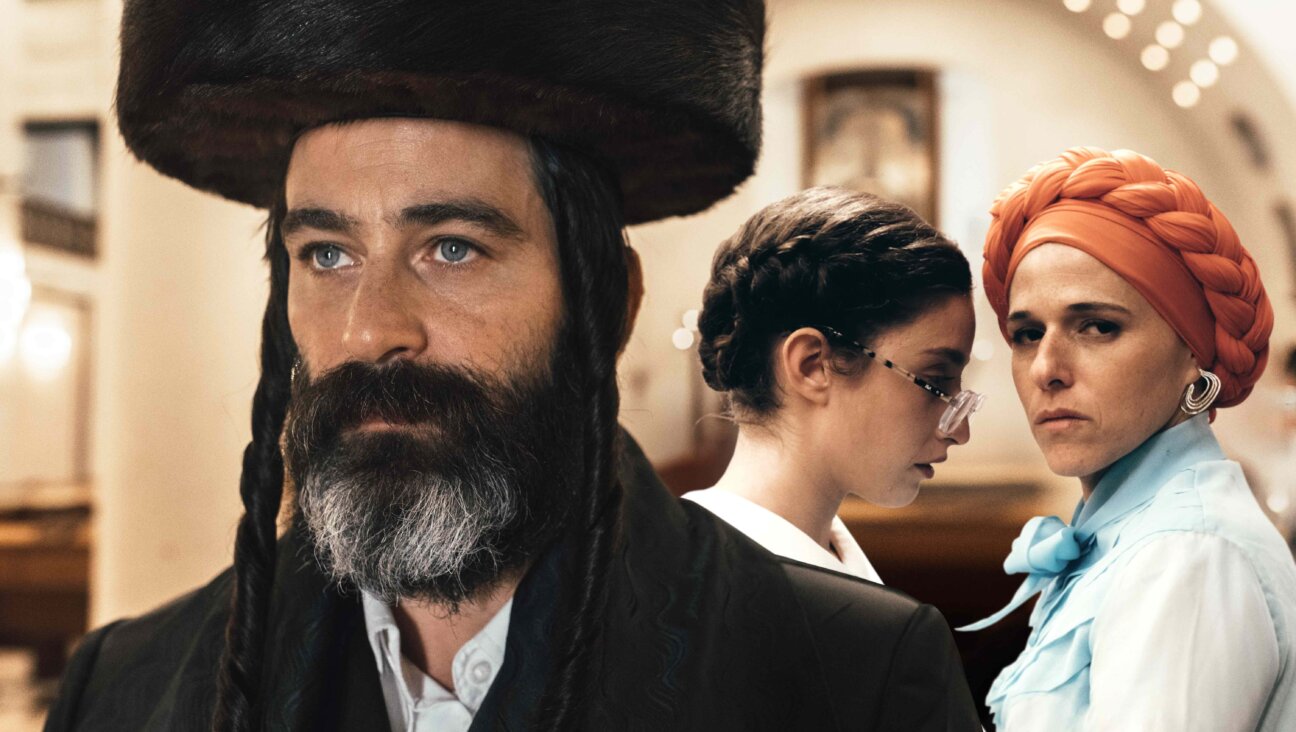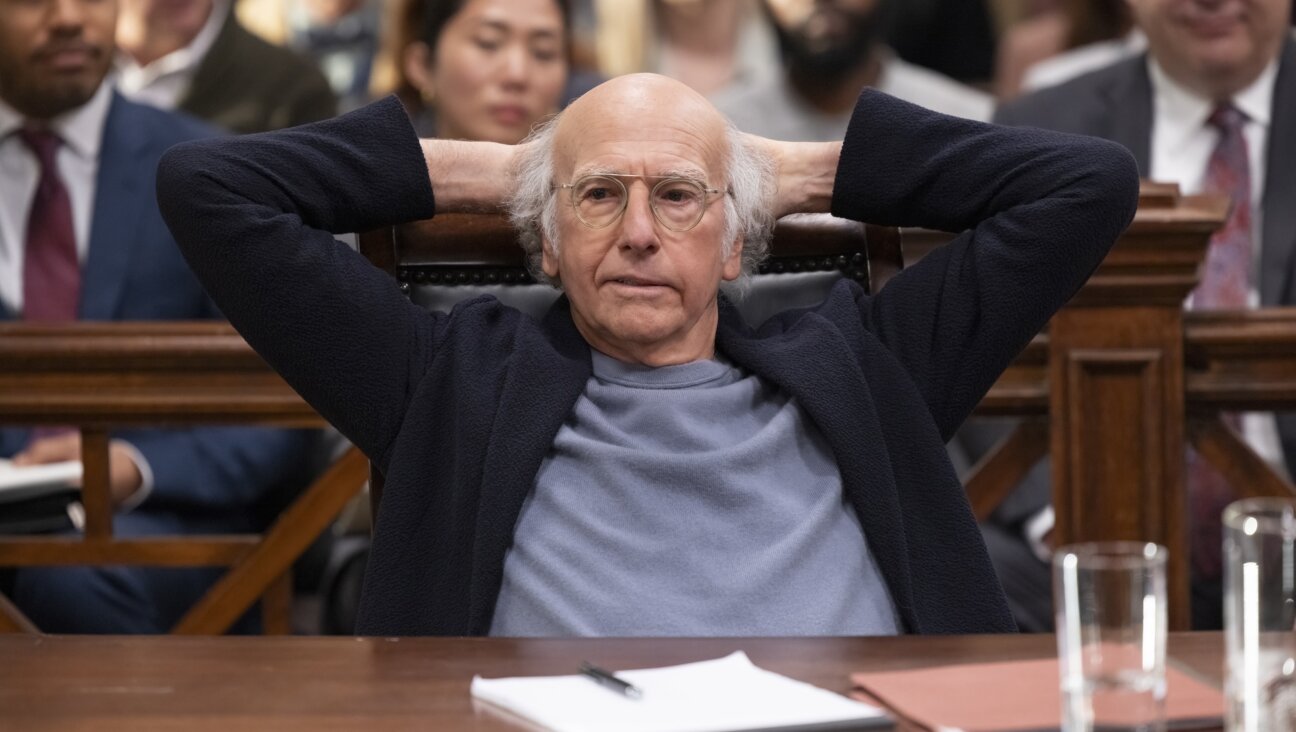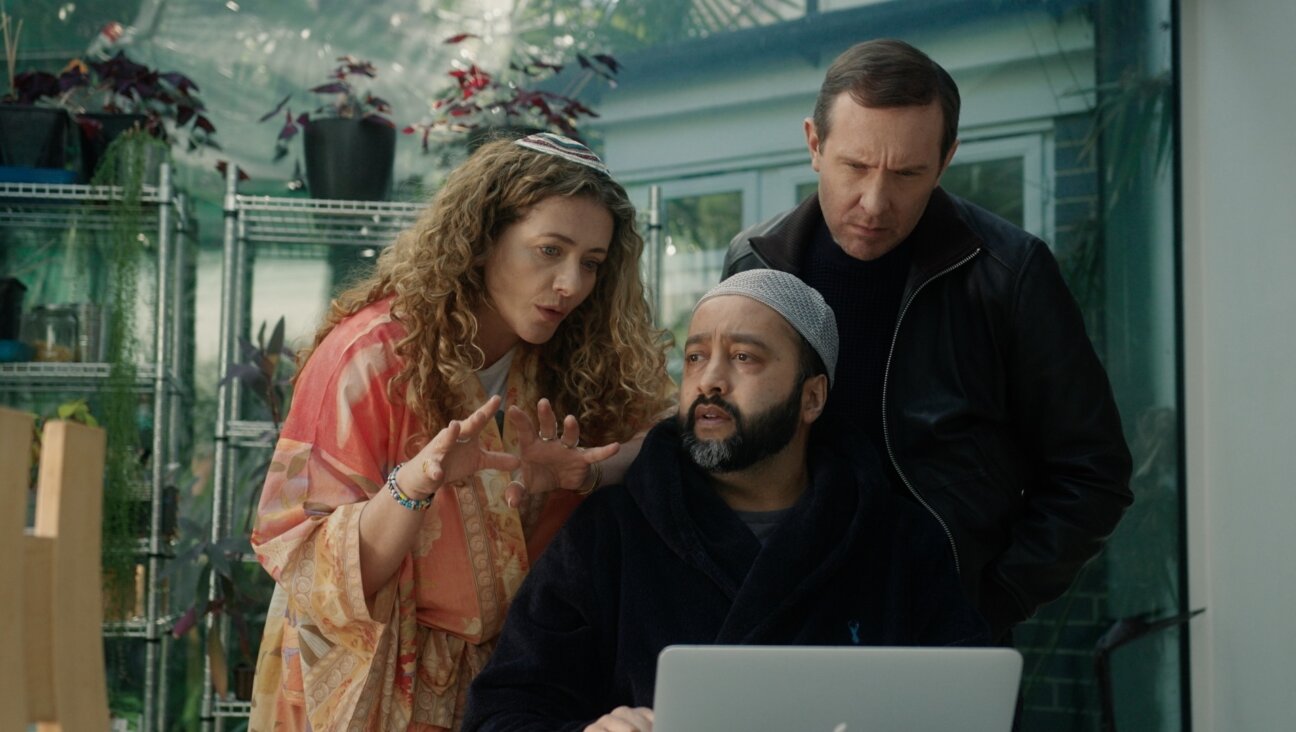A (Not-So) Brief History of Every Jewish Ritual Ever Seen On Film Or TV

Al Jolson in The Jazz Singer Image by Getty Images
I had unconsciously trained myself, as an observant Jew living among other observant Jews, to watch all television at a remove. McDonald’s ads didn’t affect me; the sandwiches on screen barely registered as food. I wore a yarmulke, but had no expectation that anyone on screen would do the same. I identified with characters and plotlines, but only to a point. My primary self, my Jewish self, was left unrepresented. It was like looking into a mirror and seeing only my cheeks reflected back.
Yes, I knew all about Jews in American television and cinema. Hollywood’s origin story, the long-lost depictions of ghettos and golems in film’s first silent decades, pro-Semitic and anti-Semitic portrayals, down through the images of wholesome Jewish families, of the Holocaust, of survivors, of single Jews, assimilated Jews, the countless obligatory ethnic episodes of long-forgotten series. Yes, but: My life was a series, not a Very Special Hanukkah Episode; watching others’ watching me (or my side-curled, black-hatted counterparts) rarely made an impact.
Every once in a while, though, there would be breakthrough moments when the American entertainment machine reached out of a secular safe space and into tradition. It was only in these fleeting moments that I felt television speaking to me, as though I were watching baseball on it and a homerun flew off the screen and into my lap.
My first experience like this was an episode of Aaron Sorkin’s “Sports Night,” in the Passover Seder that concluded the episode. It wasn’t the Seder itself that broke through, tasteful though it was; it was the final beat of the final scene, when Jeremy Goodwin (played by Joshua Malina) stands up, cup in hand, and sings the special Passover Kiddush tune with the fluency of a day school attendee.
Better still: Malina doesn’t quite say the blessing; that would involve taking God’s name in vain. Instead, he does what all day school students are taught to do: He subtly alters the names of God (Adonai Eloheinu) with similar-sounding fake words (Adoshem Elokeinu). It’s a veritable dog whistle: This is not real, only a TV show. The fourth wall had been broken and almost nobody noticed. For the first time, I found myself in American TV. The moment stuck; I wanted to find myself again. This is how I began looking for moments of Jewish ritual in America’s vast sea of TV and cinema. I have so far located almost 100.
Over the past century, American entertainment has featured snippets of almost every piece of Jewish liturgy. There have been wedding proceedings, divorce proceedings, Kiddushes, Kaddishes, Yizkors, Seders; blessings on Shabbat candle blessings, blessings on Hanukkah candles, blessings on the Torah, blessings for the mikveh, blessings on bread; brises, bar mitzvahs, burials, prayers for the sick, Torah readings, and at least one priestly blessing. In addition, there have been dozens of snippets of prayer itself: sometimes sung, sometimes chanted.
The constant cinematic interest in importing the foreign to American audiences stands at odds with the ability of the filmmakers to understand what they are importing. A director isn’t going to learn Russian just because a character is speaking the language; there must be some faith, in both the actors and the translators, that the right words are being said. Sometimes this fails spectacularly, as in a 2015 episode of “Homeland” that featured Arabic graffiticalling “Homeland” a racist show. But malicious intent is not necessary for unintended elements to enter the scene; translation does this on its own. This means, on a practical level, that a bilingual viewer will always get more than the director intended. This is especially true when the import is not just words, but also rituals. Jewish ritual has been filmed for more than 100 years.
The first ritual to be recorded was probably the Passover Seder, in the 1914 film “A Passover Miracle.” While the film itself is lost (as are 75% of silent films), the novelty of the concept is clear from a contemporary trade journal, which hails it as an “important contribution to the films which depict racial customs.” The journal further notes that production began only after the screenwriter consulted a Jewish educational bureau to find out “whether the Jewish element would object to the portrayal of one of their sacred feasts upon the screen.”
The idea was warmly welcomed by the bureau, which immediately saw the benefit of exposing American audiences to Jewish rites. The bureau began consulting on the film. A Jewish actor (an immigrant from the Ottoman Empire) was hired to ensure fidelity. Title cards were written in both English and Yiddish. In a letter to the studio, the bureau warns the producers that they may not understand everything being filmed. “Here and there in a scenario, there may be scenes which to you would seem independent of any religious element, which, however, might require a better knowledge of Jewish mass psychology than you probably have at your disposal in the studio.”
The single remaining photograph from the film attests to this care for detail: On the wall behind the lead actors hangs a portrait of Rabbi Yitzchak Elchanan Spektor, a recently deceased Lithuanian rabbi of international renown (Yeshiva University’s rabbinic school is named after him). The producers almost certainly did not know who this was; his presence attests to their willingness to cede some creative control.
While “A Passover Miracle” set a precedent for religious consultation, its ethnographic purpose is somewhat atypical: Most of the time, Jewish ritual ends up on the screen simply as an imprimatur of authenticity, as a bit of ethnic flavoring. This means, among other things, that the ritual is often the last thing one sees before a cutaway or a fade to black; you can’t really give a response to a ritual that the audience doesn’t understand. A classic example of this structure is the moving Kol Nidre sequence in the climactic final scene of the 1927 version of “The Jazz Singer.” The moment proved powerful enough to repeat in the film’s three remakes. Other TV shows and movies, from “Northern Exposure” to “Rocky III,” have followed the “fade-to-black” pattern.
With a few notable exceptions — including the haunting Kiddushby Holocaust survivor Emil Katz, which opens “Schindler’s List,” the various rituals that take place aboard a 23rd-century space station in “Babylon 5,” and the rousing singing of Israeli soldiers in the 1966 film “Cast a Giant Shadow” — American screens typically display Jewish ritual because American films are about American lives.
The various ways in which ritual enters the screen correspond to the various ways in which Jewish tradition enters the lives of Americans: through Jewish friends, Jewish neighbors, Jewish co-workers or Jewish family. Also like the lives of most Americans, Jewish ritual is something one visits and then quickly departs; TV shows will have their “Jewish episode” and then move on. “Boardwalk Empire” has a synagogue scene; there are Hanukkah blessings in episodes of “Frank’s Place,” “WIOU” and “ER”; there are elements of the Seder in “Family Guy.” Even in these brief episodes, the quality of the performance is usually quite high. Most impressive of all is Gene Wilder’s extremely accurate depiction of standard but obscure prayer: the Psalm of the Day for Thursday. To my knowledge, this is also the only Hollywood depiction of the constant sing-song mumbling that is so common in Orthodox synagogue.
Still, there is often little creativity put into the use of rituals; they are supposed to speak for themselves through their foreignness. A few shows have attempted to integrate rituals more deeply into the plot. Sometimes this is done clumsily: An episode of series “Diagnosis: Murder,” which ran from 1993-2001, includes a wedding scene in which the glass stomped on by the groom turns out to contain a bomb. A more elaborate (and funnier) scene appears in the film “A Serious Man” where the protagonist’s son is called up to the Torah for his bar mitzvah while high. The otherwise forgettable comedy “Keeping the Faith,” which centers on a rabbi and a priest, features a gospel choir singing “Ein Keloheinu.”
More recently, Jill Soloway’s series “Transparent” has featured at least one Jewish ritual per episode, each masterfully woven into the show. When the protagonist of a “Jewish episode” is Jewish, the plot is almost always about an attempt to quell some underlying struggle with Jewish ritual itself. Sometimes the struggle is about a perceived distance from one’s tradition (the “Kaddish for Uncle Manny” episode of “Northern Exposure,” several episodes of “Babylon 5”). In an episode of the 1970s series “The Partridge Family,” it’s about someone feigning Judaism before understanding the realities of observance.”
In an episode of the series “The Waltons” (“The Ceremony”), the struggle is with a family’s memory of the Holocaust and a father’s deep trauma concerning all things Jewish. In this episode, the climax comes when the father allows himself to come to his son’s bar mitzvah. The liturgy here is excellent — until the rabbi inexplicably begins “Shalom Aleichem,” a song reserved for the Shabbat dinner table.
Perhaps the best use of a Jewish ritual is in episode of “MASH,” in which the child of a Jewish soldier and a Korean woman is to be given a bris. The parents insist on a rabbi, but the closest one is on an aircraft carrier, barely within communication range. The multi-part ceremony, conducted in a mixture of English and Hebrew, is transmitted via the rabbi’s instructions through Morse code and recited by a priest, Father Mulcahy. The connection is lost at the end. and the Korean mother completes the last few words in an unpracticed Hebrew. Here, it is the rabbi’s absence and the participants’ lack of familiarity that makes the ritual feel fresh.
The American Jewish screen ritual is always a foreigner coming through the door; for most people, the fact of that foreignness is less important than its content. An episode of “Frasier” recognizes this and even pokes fun at it. In “Star Mitzvah,” Frasier recites a prepared Hebrew speech at his son’s bar mitzvah. Daphne, a gentile, sits in the audience and glows with pride. “Aw, that’s lovely!” she says in her Manchester, England, accent. But the congregation appears confused. “What was that gobbledygook?” the rabbi asks. “That mean’s nothing. It’s gibberish!” A kid in the audience figures it out: Frasier has been tricked into reciting a speech in Klingon. Watching Jewish ritual on screen, I feel the divide between “Aw, that’s lovely” and a decoding of the words themselves; by recognizing the secret history, I simultaneously recognize myself to be in the minority. The intended and secret messages are not always identical, but neither are they at odds — except for one scene, which I can’t get out of my mind.
“Once Upon a Honeymoon,” a romantic comedy starring Cary Grant and Ginger Rogers, was released less than a year after the bombing of Pearl Harbor. In the film, Grant and Rogers get stuck in Poland during the German invasion and are misidentified as Jews. “Now he thinks we’re Jewish. This could be serious!” Grant says. (Is he deadpanning, or just unaware?) They are made to wait with other Jews, presumably on their way to a concentration camp. The scene is dark and foggy; Nazis guard a group of Jewish men and women. Their faces can’t quite be discerned, but they are praying: We hear a man chanting “Shema Koleinu,” “Hear Our Voices,” one of the core texts of the High Holidays liturgy. His voice sounds pained, the way cantors force their voices to sound pained when the threat isn’t real. Did the director know, in 1942, how deep this scene would cut? Did the Jews on the recording know? Grant and Rogers are upset, but not panicked; they assume they’ll be rescued. “We’re really in a mess,” Rogers pouts. “What about these people?” Grant answers, motioning his head toward the singing crowd. For 30 seconds they remain silent while the chanting continues. Accept with mercy and favor our prayer, Grant chants in Hebrew. A chorus behind him repeats the line. Then: Fade to black.
David Zvi Kalman won a 1st place Simon Rockower Award from the American Jewish Press Association for Excellence in Arts and Criticism for his 2016 Forward article “The Strange and Violent History of the Ordinary Grogger.”

I hope you appreciated this article. Before you go, I’d like to ask you to please support the Forward’s award-winning journalism this Passover.
In this age of misinformation, our work is needed like never before. We report on the news that matters most to American Jews, driven by truth, not ideology.
At a time when newsrooms are closing or cutting back, the Forward has removed its paywall. That means for the first time in our 126-year history, Forward journalism is free to everyone, everywhere. With an ongoing war, rising antisemitism, and a flood of disinformation that may affect the upcoming election, we believe that free and open access to Jewish journalism is imperative.
Readers like you make it all possible. Right now, we’re in the middle of our Passover Pledge Drive and we need 500 people to step up and make a gift to sustain our trustworthy, independent journalism.
Make a gift of any size and become a Forward member today. You’ll support our mission to tell the American Jewish story fully and fairly.
— Rachel Fishman Feddersen, Publisher and CEO
Join our mission to tell the Jewish story fully and fairly.
Our Goal: 500 gifts during our Passover Pledge Drive!
























